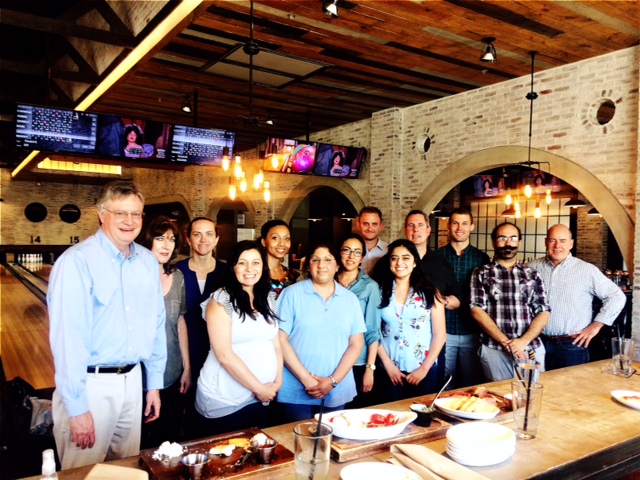Company History
StemBioSys® management and staff at a team building event in the Summer of 2017.
StemBioSys® – The Next Evolution in Cell culture
As a tenured professor at UT Health San Antonio, Dr. Xiao-Dong Chen was performing research with mesenchymal stem cells (MSCs) and, like many other investigators, became frustrated when MSCs lost their stem cell properties during cell culture expansion on ordinary tissue culture plastic (TCP). Dr. Chen recognized that critical features of the stem cell niche were absent in TCP and this created a hindrance to obtaining large numbers of high-quality cells. The solution was to replicate the physiological microenvironment in the body and hence Dr. Chen developed the patented CELLvo™ Matrix. The CELLvo™ Matrix allows MSCs to expand quickly, reliably and with less donor variability, while largely maintaining their stem-like properties.
ON A TRIP TO CHINA
Although CELLvo™ Matrix proved to be a great solution for Dr. Chen, it was only known to his laboratory and a few collaborators until he teamed up with Dr. Steven Davis to commercialize the product. A dermatologist in San Antonio, Dr. Davis first learned about Dr. Chen’s technology from Ann Stevens, President of BioMed SA. Dr. Davis happened to be on a family trip to China coincidentally at the same time that Dr. Chen was visiting his native Shanghai as a part of the San Antonio Chamber of Commerce delegation with the City of San Antonio. While on a bus ride, Dr. Chen discussed his stem cell research with Dr. Davis and it was then that they decided to form a partnership. With seed funding secured, the two were able to obtain licensing rights to the technology from UT Health San Antonio. They hired key staff members, got additional funding from “family and friends” and recruited an elite local Board of Directors. Their idea was now a company — StemBioSys®, Inc..
PARTNERSHIP AND COLLABORATION
As a platform technology, the newly patented CELLvo™ Matrix has been further developed to support other scientists in their stem cell research. The team at StemBioSys knew that partnership and collaboration with leading research and bio manufacturing institutions were the key to unlocking the value of this newly developed technology.
StemBioSys recruited MIT’s renowned bioengineer, Dr. Robert Langer, to join its board from the start. Langer’s lab explored why the CELLvo™ Matrix worked as well as it did and how it could help improve the quality and speed of cell expansion. Several articles in peer-reviewed scientific journals were published that establish CELLvo™ Matrix as a true innovation in stem cell research. Research collaboration between StemBioSys and other well-known institutions soon followed, each producing promising results and increasing the potential opportunities for the company.
CONTINUED EVOLUTION
An early partnership with BioBridge Global allowed for the establishment of a state of the art manufacturing facility on the BioBridge campus in San Antonio just a few miles from the StemBioSys corporate and R&D facility. This partnership expanded to include a BioBridge subsidiary, Gencure®, supplying tissue for the isolation of a new line of potent human cord blood derived endothelial cells, CELLvo™ Human Endothelial Progenitor Cells (EPCs). When grown on the CELLvo™ Matrix, these cells proved to be more proliferative and more angiogenic than other endothelial cell types. Today, Gencure® supplies tissues for many of StemBioSys’ cell products.
The wide range of possibilities and market demand in stem cells has enabled StemBioSys to turn a single cell expansion platform into an extended line of high quality cells and cell expansion tools that are innovating the field of regenerative medicine.
REAL LIFE IMPACTS
Although StemBioSys’ products are strictly for research purposes today, they have tremendous potential for clinical use in the future. Rapid expansion of specialty cells and various forms of the CELLvo™ Matrix are positioned to play a key role in many areas of regenerative medicine: cardiology (replacing heart tissue), diabetes (improving production of insulin), osteoarthritis and Parkinson’s disease (repairing damaged nerve tissue) to name a few.
With StemBioSys, the next evolution in Stem Cell Research is here.

